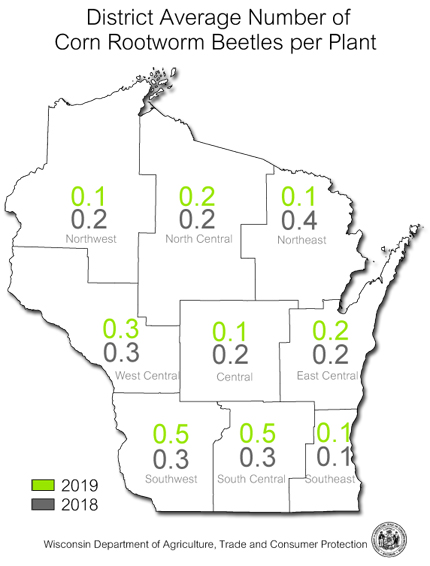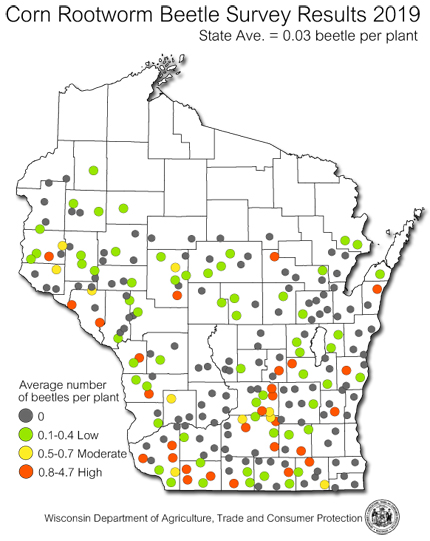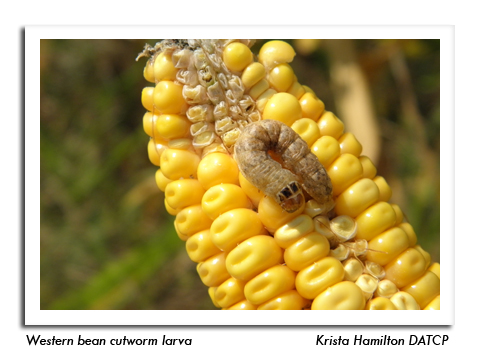
 |
|
|
Corn
Volume 64 Number 18 Date 08/29/2019 CORN ROOTWORM - The annual survey conducted from August 1-26 documented an increase in adult rootworm populations in the southwest and south-central areas and very low pressure in the other seven crop reporting districts. District averages in the northern, central and southeastern regions remained at or below 0.3 beetles per plant for the third year in a row, while averages in both the southwest and south-central areas rose from 0.3 beetle per plant last year to 0.5 per plant this season. About 20% of the southern fields sampled had economic populations of 0.75 or more beetle per plant, with the highest counts (4.3-7.2 beetles per plant) noted in Grant and Columbia counties. Despite increases in the two of the nine crop districts, overall beetle populations were low again this year. The 2019 state average count is 0.3 beetle per plant, which is only marginally higher than the historically low 2017 and 2018 averages of 0.2 per plant, the lowest since surveys for this pest began in 1971. Above-threshold counts of 0.75 or more beetles per plant were found in 27 of 229 (12%) fields surveyed, compared to last year's 20 fields (9%), while no beetles were observed in 120 (52%) of the sites. The 2019 total count of 711 beetles was 26% higher than the 566 beetles counted in 2018. In addition, again this season the northern species outnumbered the western species by a more than 2:1 ratio. Of the 711 beetles counted in this month, 499 were the northern variety, 207 were westerns, and 5 were the southern species. Last season, 379 northerns and 187 westerns were counted for a survey total of 566 adult rootworms in 2018. The northern corn rootworm has been the predominant species in the state for six consecutive years. WESTERN BEAN CUTWORM - Larval infestations have been noted in Columbia, Green Lake, Marquette, and Winnebago counties in the last two weeks. In all instances, the o.75 to 1.5-inch caterpillars were located in the ear tips where control is ineffective. Most larvae were in the late instars and should enter the pre-pupal overwintering stage by early September. CORN EARWORM - Late-season migration flights continued this week. The DATCP pheromone trapping network captured 158 moths in 9 traps between August 22 and 28, for a cumulative total of 792 moths since mid-July. The high count for the reporting period was 88 moths at Mayville in Dodge County. The latest activity signals that fresh market and processing sweet corn remains at risk of infestation and should be monitored until harvest. Counts for the week ending August 28 were: Arlington 2, Beaver Dam 13, Bristol 35, Coon Valley 0, Cottage Grove 8, Janesville 2, Madison North 0, Marshfield 2, Mayville 88, Pardeeville 0, Ripon 4, Sun Prairie 0, Watertown 4, and Wausau 0. EUROPEAN CORN BORER - The second flight of moths has continued at very low levels (< 12 moths) at a few black light trap locations. Surveys in corn show that larvae range from second- to fifth-instar in the western and central districts, as far north as Chippewa County. Larval infestations affecting 2-24% of corn plants were noted in 8% of fields checked from August 22-28. The ECB larval treatment window has closed for the season across the southern and central counties. -- Krista Hamilton, DATCP Entomologist 




.jpg)
|
|
|